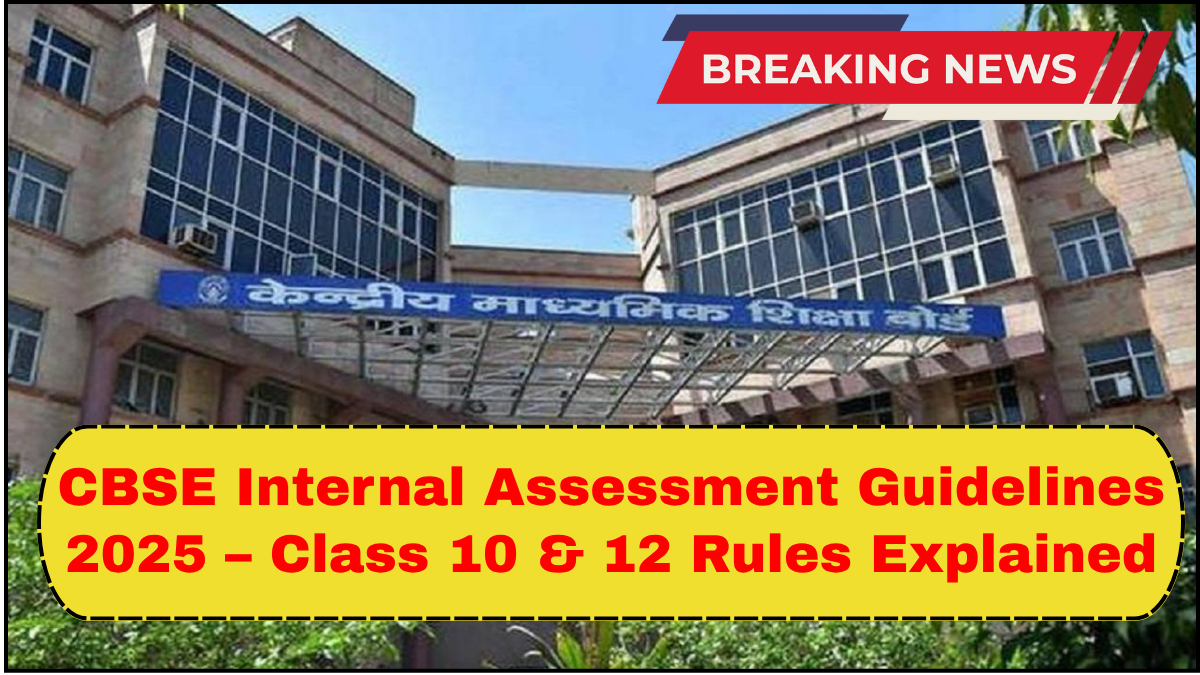The Central Board of Secondary Education (CBSE) has officially released the CBSE Internal Assessment Guidelines 2025 for Class 10 and 12 students. These updated guidelines bring more clarity and structure to how students are evaluated beyond final board exams. With a strong focus on skill development, critical thinking, and hands-on learning, the board’s internal assessment rules aim to foster a more balanced academic environment.
Let’s break down everything students, teachers, and parents need to know about the Class 10 & 12 project rules, subject-wise weightage, assessment criteria, and the changes introduced in the 2025 session.

What Is Internal Assessment?
Internal Assessment refers to the evaluation conducted by schools throughout the academic year. Unlike board exams, which are centralized and conducted externally, internal assessments are managed by school faculty and include various forms of evaluations such as:
-
Periodic tests
-
Projects and practicals
-
Assignments
-
Class participation
-
Portfolio submissions
These components ensure that students are consistently engaged and evaluated on more than just rote memorization.
CBSE Internal Assessment Guidelines 2025: Key Highlights
CBSE has fine-tuned its assessment policy for 2025 to align with the National Education Policy (NEP) goals. Here’s what’s new and important:
1. Consistent Weightage Across Subjects
-
Class 10: Internal assessment carries a 20% weightage.
-
Class 12: Varies by subject. For subjects with practicals, internal marks typically range from 20 to 30.
This consistent approach across subjects ensures fairness and accountability in scoring.
2. Emphasis on Skill-Based Learning
Projects and assignments are now being structured to reflect real-world problem-solving skills. For instance, science projects may focus on sustainable practices or local environmental issues, while commerce students might explore case studies based on current market scenarios.
3. Structured Project Work Guidelines
Each project or practical assignment must follow a clear format, including:
-
Title and objective
-
Methodology or procedure
-
Observations and analysis
-
Conclusion
-
References or bibliography
These formats help standardize the quality of submissions across schools.
4. Inclusion of Portfolios and Subject Enrichment
Students are required to maintain portfolios in subjects like English, Hindi, and Fine Arts. These portfolios include:
-
Creative writing samples
-
Grammar worksheets
-
Reading logs
-
Visual artwork (for Fine Arts)
This initiative encourages students to maintain a record of their learning process throughout the year.
Class 10 & 12 Project Rules: Subject-Wise Breakdown
Let’s take a closer look at the Class 10 & 12 project rules subject-wise:
Class 10 Internal Assessment Overview
-
Science: Practical experiments, viva, and lab manuals (20 marks)
-
Mathematics: Periodic tests, assignments, and project work (20 marks)
-
Social Science: Map work and one project (20 marks)
-
Languages (English, Hindi, etc.): Listening and speaking skills, portfolio (20 marks)
Class 12 Internal Assessment Overview
-
Physics, Chemistry, Biology: Practical file, experiments, viva (30 marks)
-
Accountancy, Business Studies, Economics: Case studies and market surveys (20 marks)
-
Computer Science/Informatics Practices: Programming projects and practical tests (30 marks)
-
Languages: ASL (Assessment of Speaking and Listening) and portfolio (20 marks)
Evaluation Criteria: How Are Students Graded?
The CBSE Internal Assessment Guidelines 2025 emphasize transparency in grading. Teachers are required to:
-
Maintain detailed records of student performance.
-
Use rubrics for fair evaluation.
-
Provide feedback after every assessment.
Each component (test, project, class activity) contributes to the final internal score and must be documented properly.
Why Internal Assessment Matters More Than Ever
CBSE’s renewed focus on internal evaluation reflects a global shift towards continuous assessment. It rewards consistent effort, creativity, and engagement rather than last-minute cramming. For students aiming for higher education, these internal scores may also be used in holistic admission processes, especially with the introduction of CUET and similar national entrance formats.
FAQs on CBSE Internal Assessment Guidelines 2025
Q1. Are internal assessment marks added to the final result?
Yes. Internal marks are added to board exam scores to calculate the final result. These marks carry significant weight, especially in Class 10.
Q2. Can poor internal marks affect my overall performance?
Absolutely. Scoring low in internal assessment can reduce your overall percentage. Regular class participation and quality project work are essential.
Q3. Are internal assessments the same in all CBSE schools?
While the guidelines are common, the implementation can slightly vary. However, CBSE mandates record-keeping and moderation to ensure standardization.
Q4. How many internal tests are conducted?
Typically, schools conduct 3 periodic tests along with assignments and project work, though exact schedules may differ.
Q5. What if a student misses an internal assessment?
In genuine cases like medical emergencies, schools can arrange alternate assessments. However, skipping assessments without valid reasons can lead to zero marks.
click here to learn more